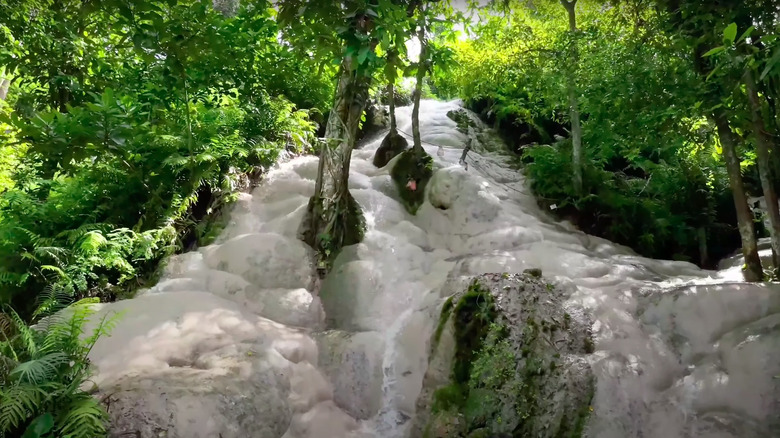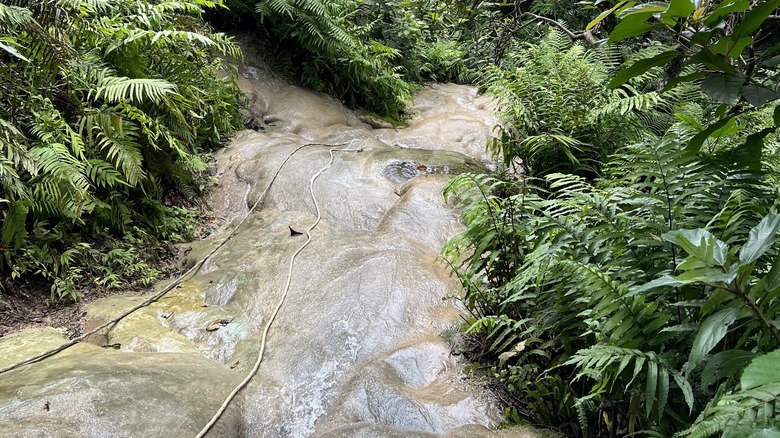The Unique Phenomenon That Makes This Bucket List Thailand Waterfall Easily Climbable
Thailand is brimming with bucket list-worthy locations. From its incredibly popular and pristine beaches to its ethical elephant sanctuaries perfect for animal lovers, the Southeast Asian destination has a long list of attractions and activities that you simply can't miss during your visit. One of these must-visit places is Chiang Mai.
The largest city in northern Thailand, Chiang Mai is typically known for its rich cultural heritage and vibrant markets. However, outside of the city's walled old town, there's a variety of outdoor activities and natural wonders that make for the perfect escape from the hustle and bustle. One of these gems is the so-called "Sticky Waterfall," or Bua Tong Waterfall.
Located inside Namtok Bua Tong-Nam Phu Chet Si National Park and roughly 40 miles north from Chiang Mai city center, the falls are a popular attraction with locals and tourists alike who flock to the park in order to enjoy a very unique feature: the porous limestone rocks that make it very easy to climb the waterfall — despite how steep and slippery it might look from afar.
Limestone rocks are to blame for its stickiness
So, what makes Bua Tong Waterfall so "sticky?" Put simply, it's all thanks to the limestone rocks that make up the fall. Unlike typical waterfall rocks, which can be slippery and challenging to climb without the right gear, the rocks at Bua Tong Waterfall feel almost like a coarse and grippy sponge. This — combined with the fact that no algae grows on the rocks, which would typically make the rocks slick and hazardous — provides a natural grip for your feet that, in turn, makes the rocks easy and safe to scale with little to no effort. So much so that, after a day of climbing and exploring the falls, all that'll be left to ask is: "Spiderman, who?"
@fuelforthesole 📍Sticky Waterfall, aka Bua Tong Waterfall, Chiang Mai, Thailand. 🚘 Just over a 1 hour drive from Chiang Mai Old Town. 🎟️ FREE entry! #chiangmaithailand #whattodointhailand #travelcreator
In addition to its unique texture, Bua Tong Waterfall also has four levels — one above you from the entrance, and three below — that you can explore as you wish. Ideally, your best bet to enjoy the waterfall is to take the walking path all the way down to the bottom level, and then start climbing your way up from there. As for safety, don't worry. The waterfall is lined with ropes to make the ascent a lot more comfortable if you're still not too sure about the grip factor.
How to visit Chiang Mai's famous Sticky Waterfall
The easiest way to visit Bua Tong Waterfall is via a guided tour, especially if you're worried about transportation and logistics. Plus, certain tours also combine Bua Tong Waterfall with other major attractions in Chiang Mai, meaning that you can explore the area a lot more conveniently. However, like with most group tours, it's worth noting that visiting the falls as part of a guided outing means you're subject to following their schedule, taking away the freedom to simply climb and explore the falls at your own pace. As for choosing the right agency, one of the most popular options is Pon Tours Chiang Mai (also called Pon Elephant Thailand), which currently holds a 5-star rating on TripAdvisor and offers a guided Bua Tong Waterfall and Doi Suthep Temple visit for about $45 per person.
Alternatively, the more adventurous travelers can also hire a motorbike and head over to the Sticky Waterfalls on their own. From there, the Namtok Bua Tong-Nam Phu Chet Si National Park where the falls are located is easy to find using a navigation app like Google Maps. In terms of pricing, renting an automatic scooter will set you back anywhere between $4 to around $7 a day, plus a deposit (up to around $55) that you'll get back after you return the bike in good condition.


